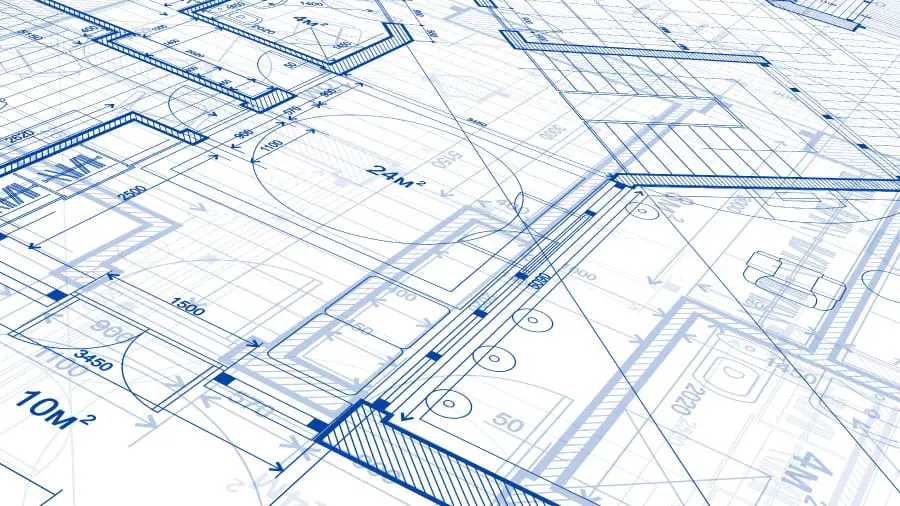Here’s Why Architects Write in ALL CAPS – (With Examples)
Architecture, as a profession, relies heavily on communicating through visual means. This involves using both drawings and words to describe the drawings to create a clear picture of what the architect intends for the building.
Since architects have regulated how drawings should be drawn and what drawings should show, it only makes sense that architects would also create a standard for how words should be used when describing objects.
Architects write in ALL CAPS to differentiate letters since some lowercase letters look similar to other uppercase letters. Communication and being concise with information is vital in the field of Architecture. Multiple professionals will be working with their documents, and all information should be understood at a glance without needing any clarifications.
In this article, we’ll be going more into why ALL caps are used, how communication works in the construction business, and how much information is actually conveyed in architectural drawings.
Read on if you plan on working with an architect anytime soon or if you wish to familiarize yourself with the reasoning for the industry’s standards for communications and why it works.
What is it about ALL CAPS that makes it preferable for architects?
Uppercase letters, or ALL CAPS, has the following properties that make it ideal for clearly conveying information.
- ALL CAPS will always be above the drawing line. Writing in all caps is a guarantee that all of your letters can fit in a uniform way. It’s possible to write all the letters within a certain measurement and without having any of the letters extending from a certain boundary
Examples:
- “G” compared to “g”
- “Y” compared to “y”
- “Q” compared to “q”
- “P” compared to “p”
- Each letter in their upper case form is visually distinct from the others. Aside from the field of architecture, most, if not all, institutions will require ALL CAPITAL letters when filling out important documents, especially those related to information (Birth Certificate, Driver’s License, Social Security, etc.). This is to ensure that the information given is less likely to be misinterpreted by the reader.
For example, the letters “P,” “Q” and “B” are visually distinct from one another right of the bat, while the lower case counterparts of these letters “p,” “q” and “b” is just the same character flipped in different ways.
- Put yourself in the scenario of a contractor reading the plans, compare these two lines of information, and ask yourself, “Which one conveys information better?”
- “300 MM X 300 MM RC COLUMN”
- “300 mm x 300 mm rc column”
The difference in visual impact and clarity between the two cases is staggering.
Why communication is so important in the building industry
Communication is important in the industry for two main reasons:
- To avoid mistakes
If an architect were to, for example, decide not to use all capital letters, it would cause a lot of confusion, especially for drawings that require a lot of text. The less visual “noise” the drawing has, the better it can be understood and processed by the reader.
- To save time
Good communication is to give everyone involved a full picture at all times. The only difference is that the “picture” isn’t always set and always changing. It’s important that everyone is on the same page and not left behind to avoid errors, which costs time and money.
- To save money
It’s often drilled in architecture school that plans aren’t “just drawings.” Although, that’s what it appears to be to a regular person. Architectural drawings are to be treated as a literal representation of what the building will be built as.
To further expound on this point, every line in a drawing is measured, whether it be the width of the planks on the floor or the tiles in the bathroom. There is no room for error and mistakes, and creating a finalized construction drawing with all the necessary details takes days.
Imagine this scenario, the architect does not clearly explain the intention of their drawings. When the contractor begins to work on them, one of the two things will happen:
- The contractor ends up making a mistake, believing they were following the plan correctly and ends up building the house with the wrong finish/materials/method of construction.
- The contractor is constantly confused and has to repeatedly ask the architect for clarification in every step of the project. This wastes a lot of time and will most probably end up causing extensions in the project.
Both outcomes will cost the clients more money, a less efficient workflow, and, most probably, a worsened output.

What do architects communicate in a drawing?
Architects have to communicate all the relevant information that a certain drawing requires.
For example, it wouldn’t make much sense to do callouts for piles on a foundation plan. Instead, piles should be called out in the section drawing of a “typical” column.
In drawings, the architect always shows the output of the construction, and it is up to the contractor to reach this output.
How do architects communicate in a drawing?
In an architectural drawing, there are 3 key details that an architect always puts.
- Measurements
Measurements are already a given. The architect draws the structure to a certain scale to ensure that everything fits and gives measurements so that the client can also imagine the size of the spaces within the building.
Incorrect measurements can lead to either more expenses, small spaces once actually built, and in some cases no room for fixtures.
- Labels
The label is a wide term used either to name the drawing, to name the spaces within the drawing, and to name the measurements (depending on the drawing).
Labels are important because certain spaces come with certain implications.
- Callouts
Callouts are used to call out details within a space. What you call out depends on what drawing you are currently detailing.
For example, on a floor plan, the architect would make callouts for the floor finish. While for an elevation, the architect would make callouts for the walls, windows, and doors.
These three key communicators within the drawings create a system where other professionals can easily understand the drawing and would be able to imagine what the actual building would turn out like.
As a client, what do I need to understand about an architectural drawing?
If you’re the client, it’s the architect’s job to MAKE you understand what’s happening at all times. It’s not expected that everyone is going to know what the drawings represent, and it’s the sole responsibility of the architect to make sure you know EXACTLY what you’re paying for.
Here are some tips to get an even better understanding of how something is going to be built and how to better communicate with your architect:
- Understand what a meter/feet is. Architect’s minds are trained to easily discern what a meter looks like and can probably make a guess that’s only a few centimeters off.
- Read about what you ask. The architect may be trained in communication but they may find it difficult to sometimes convey things to clients.
“A classic example of this is asking for a certain style. Imagine asking for an authentic igloo-styled house if you live in the tropics. It sounds silly, doesn’t it? The same goes for asking for an Asian styled structure, whether it be in terms of construction, materials, or aesthetic if you live in an area that experiences a completely different climate from the style you wish to get.”
Conclusion
Communication is an important aspect of any industry. In architecture, good communication of plans is vital to a successful and efficient construction project.
The current system of how architects communicate their drawings works because architects use a standardized method of combining both drawings and words to give out their intentions clearly, and using ALL CAPS is a part of that system.







